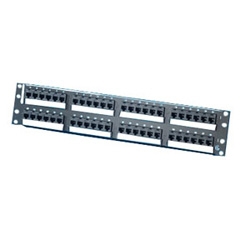Patch Panel Label Template
Find CommScope structured cabling system label templates. PATCHMAX PowerSUM Patch Panels Available Label Stock. MFTP and HFTP Shielded Panel Label Template A4. Label Template Download. Where can I find laser and inkjet label templates to use without. Labels for NK6PPN48P and NK6PPN24P Patch Panels; Brady Labels With A.

I do a combination of a spreadsheet and a diagram. The diagram is basically a map designed to show the coding/labelling scheme of the patch panels and ports.
The Spreadsheet acts as a legend for the map so that it isn't cluttered with connecting lines. A tend to go PP-A-1 or SW-A-1 with PP designating patch panel and SW designating switch, the letter shows the position on the rack in sequence and the number is port number. You can also save Visio diagrams as JPEGs for portability just keep the original for editing purposes.

Hi all; As a phone tech from last century I'd like to give my two cents worth on this. In the good old days we used to provide a double accounting approach, that is, each end point had the other end point noted. Sticking with the whole telecoms feel a jumper between two pairs would be recorded in two places.
For example at the mainframe of a building - the point where the incoming cable from the telephone exchange (Central Office for those in the US) terminates into a building I would have receorded the following: In the mainframe record book I would have the two entries as follows: Main cable Pair - Jumpered to - Riser Pair, and Riser Pair - Jumpered to - Main cable Pair. Each record would be in a different section of the record book as each vertical (whether Krone, or 101 blocks or solder tags) is considered a record space. What I would suggest to you, and I have attached an empty excel spreadsheet for you all to look over, is an excel version of this. Further I would suggest a naming version similar to: Location1-Location2-HardwareType-Number.Port_Number such that something in building 1, floor 1, on the Coreswitch 0, port 1 would show as: bld1-fl1-csw-0.p1. What you use for your terminology is up to you, but stick with something that anyone using a little bit of common sense, a vizio diagram and your record in excel or whatever, should be able to figure this out.
Ideally a master codex that provides the understanding to unlock your hardware or asset naming scheme would be ideal. And I agree with Jen and her P-Touch (or Dymo Lable Maker for that matter) approach. Label everything in your comms rooms. Take a look at the spreadsheet (it is unlocked and open for your use) that is attached and let me know if anything is unclear. Hope this helps everyone in the community. I was going to chime in here but everybody beat me to the diagram + spreadsheet approach. I find that different types of documentation require different formatting or tools.
I don't like the maintenance involved in most methods. Too much overhead. I started decades ago with the idea that everything should be documented in some sort of overarching means and I eventually decided Visio was the answer. Over the years I swung back the other way to just using a composition book per server and then to wanting to web app everything. Most recently my thought were to using a wiki with table capability to handle everything. I still think that that coupled with scriptability and possibly some sort of basic we based diagrammer would be the ideal. That said, racktables looks pretty darn neat.
I am going to go play with that for a while and see how I feel about it. Arcserve Ctf File Extractor here. So far everybody is making due with either visio or excel or a combination of the two the only other app should then be racktables but unfortunately this lacks patch panel documentation which was my original question what I was hoping for is a working template in whatever format that gives anybody a clear view of what goes where on any patch panel, be it LAN or phone or fiber. A web service like racktable sounds great, and a motivation to finally do something with my study of asp.net;-) has anybody heard of a paying solution? Iandrewmartin wrote: Hi all; As a phone tech from last century I'd like to give my two cents worth on this.
In the good old days we used to provide a double accounting approach, that is, each end point had the other end point noted. Sticking with the whole telecoms feel a jumper between two pairs would be recorded in two places. For example at the mainframe of a building - the point where the incoming cable from the telephone exchange (Central Office for those in the US) terminates into a building I would have receorded the following: In the mainframe record book I would have the two entries as follows: Main cable Pair - Jumpered to - Riser Pair, and Riser Pair - Jumpered to - Main cable Pair. Each record would be in a different section of the record book as each vertical (whether Krone, or 101 blocks or solder tags) is considered a record space. What I would suggest to you, and I have attached an empty excel spreadsheet for you all to look over, is an excel version of this. Further I would suggest a naming version similar to: Location1-Location2-HardwareType-Number.Port_Number such that something in building 1, floor 1, on the Coreswitch 0, port 1 would show as: bld1-fl1-csw-0.p1.